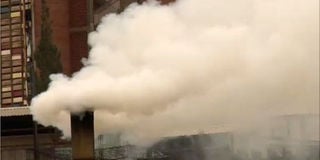Stop the dangerous levels of air pollution

A factory releases fumes in one of the industrial areas in Kamapala.
What you need to know:
The issue:
Air pollution
Our view:
Both local and central governments need to build capacity for air quality management and monitoring teams and enforcement mechanisms in order to protect and improve our public health.
We are all breathing in contaminated air and endangering our lives. A recent report by Water and Environment ministry says Ugandans are generating twice more volume of polluted air than they did 14 years ago in 2005 (See: “Gas emissions on rise’ in the Daily Monitor of November 12). More distressing is the fact that this unhealthy air we breathe-in, is twice unhealthier than levels recommended by WHO, the United Nations health watch agency.
But the good thing is that we all know the sources of these pollutants. Our national environment agency Nema singles them out as the heavy traffic of imported second-hand and reconditioned vehicles, ageing, exhausts, and unregulated flow of vehicles, trucks, buses, and motor-cycle taxis, commonly known as boda bodas.
Also, Nema warns that these automobiles burn nearly 140,000 litres of fuel as they idle in daily traffic jams in Kampala, costing Shs500 million. More fumes or carbons are also released into the air by both small-scale and big industries. Dangerous emissions from these vehicles, plus dust from unpaved roads, and open burning of wastes, have been cited as one of the greatest generators of pollution and their consequent risks, especially in Kampala.
The reassurance is also that we can lessen pollution and the dangers it poses to our health. It should, therefore, be now that we worry, pay attention to this rising bad air emission and quickly act to stop the risks.
Our inaction plus the devil-may-care destruction of forests and wetlands for unhealthy urban expansion and farming risk getting our blood vessels narrowed or blocked by these impurities. These pollutants, cited in Journal of Environmental and Public Health, February 2014, are likely triggers of heart attacks, chest pain, stroke, or other respiratory diseases, including as asthma, chronic bronchitis, lung cancer, and pneumonia.
But these escalating unhealthy gas emissions can be cut down by 2030 as the government projects. This demands that we take some practical but may-be-unpopular steps.
We may have to drive less, encourage walking, and proper disposal of garbage. But this also requires adopting and enforcing international protocols on ensuring air quality, introducing non-motorised transport (NMT) and streets in Kampala and upcoming cities. The pilot conversion of Namirembe Road and Luwum Street to create a pilot NMT corridor in Kampala is a great way forward for both good air quality and healthy living.
Besides, both local and central governments need to build capacity for air quality management and monitoring teams and enforcement mechanisms in order to protect and improve our public health.
Our commitment to you
We pledge:
• To be accurate and fair in all we do.
• To be respectful to all in our pursuit of the truth.
• To refuse to accept any compensation beyond that provided by Monitor Publications Ltd. for what we do in our news gathering and decision-making.
Further, we ask that we be informed whenever you feel that we have fallen short in our attempt to keep these commitments.
[email protected]


